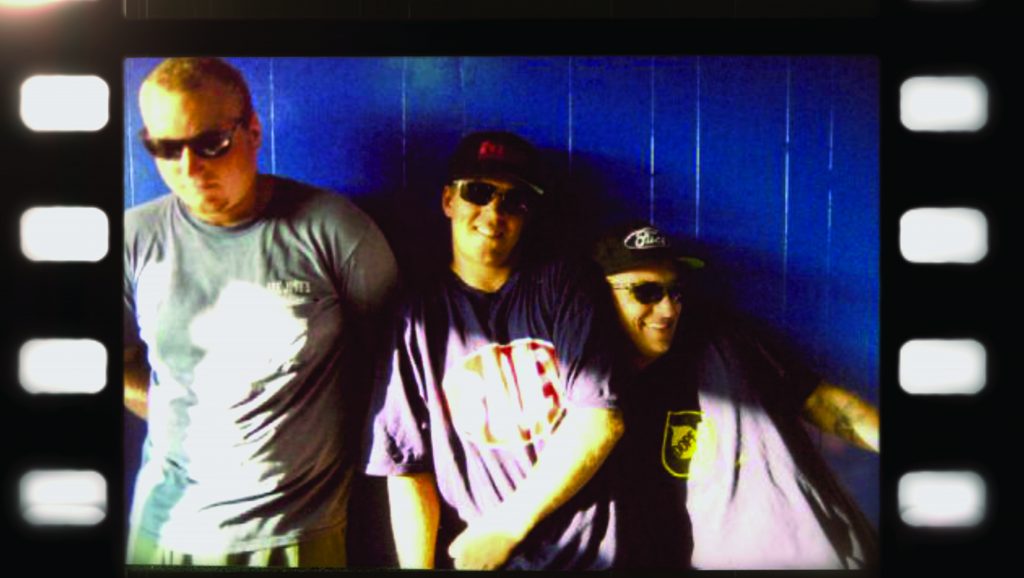April 29, 2019
by Carla Hay

“Sublime”
Directed by Bill Guttentag
World premiere at the Tribeca Film Festival in New York City on April 28, 2019.
The history of ska-rock band Sublime is tied to the tragic string of rock-star deaths in the 1990s, when several lead singers of famous bands died too young, with each singer leaving behind an infant/toddler child to grow up without their father. Nirvana’s Kurt Cobain, INXS’s Michael Hutchence, Blind Melon’s Shannon Hoon and Sublime’s Bradley Nowell all share this deadly legacy. The documentary “Sublime” is a fairly conventional but well-made telling of the band’s story, with new commentary from the surviving members of Sublime, their associates and several of Nowell’s family members.
Since most people who see this movie already know what happened to Nowell (he died of a heroin overdose in 1996, at the age of 28), the documentary is essentially a ticking clock to what we know is going to happen at the end of the film. Is it depressing? Yes, in some ways. But under director Bill Guttentag’s storytelling style, he makes sure that there are plenty of happy memories told without glossing over the dark pattern of behavior that led to Nowell’s death.
We’ve all heard this story before: Band struggles for years in the local music scene. Band slowly builds a following. Band gets a record deal. Band gets a big hit and becomes famous. Band struggles with fame, egos and drugs. Band burns out and either breaks up or goes on a downward spiral.
In the case of Sublime (whose band name came from Nowell’s then-girlfriend picking it out of a dictionary), the band’s breakup was an unexpected occurrence caused by Nowell’s death, but Sublime had already been headed down the “burnout” path even before Nowell’s untimely passing. Sublime—formed in 1988 in Long Beach, California—was part of a music scene in Southern California that blended influences from punk, ska, reggae, hip-hop and rock. It was a scene that was also racially integrated, as Fishbone’s Angelo Moore, former Sublime drummer Marshall Goodman (also known as Ras MG) and Sublime friend Opie Ortiz remember in the documentary. Goodman was eventually replaced on drums by Floyd “Bud” Gaugh, but he continued to work with Sublime as a songwriter. Singer/guitarist Nowell, drummer Gaugh and bass player Eric Wilson were Sublime’s trio lineup that recorded all three of the band’s studio albums.
Although Nowell came from a comfortably upper-middle-class family, he and the rest of the members of Sublime lived a fairly scrappy existence in their road to stardom. At one point, drummer Gaugh was homeless. One scene in the documentary includes archival footage of Sublime on stage at a club in the band’s early days, with Nowell announcing that the band needed a place to sleep, and asking if anyone in the audience had a lawn to spare.
No Doubt was also part of the late ’80s/early ’90s music scene in the Long Beach/Orange County area of California, and the band did several concerts with Sublime before and after they had their first big hits. Both bands had respect for each other and they both released music on indie labels before signing to major record companies. But the two bands were very different from each other. The documentary mentions several times that Sublime was the counterpoint to No Doubt.
No Doubt’s lead singer Gwen Stefani, bassist Tony Kanal and guitarist Tom Dumont are all interviewed in the film. They all tell stories of the differences between both bands when they toured together. Backstage before a show, the members of No Doubt would be most likely doing vocal warmups or working out, whereas Sublime would be doing hard drugs like meth, cocaine or heroin. No Doubt was the kind of band that would show up on time, whereas Sublime would be the type of band that was constantly late, if they showed up at all. No Doubt was inoffensive. Sublime was controversial. The No Doubt comparison in the movie is important because it makes people wonder how far Sublime would have gone and how long Sublime would have lasted if the band members’ hardcore drug addictions hadn’t derailed their momentum.
Stefani, who says she used to have a crush on Nowell in Sublime’s early days, describes him in a way that is consistent with what everyone else in the film says about him. He was very intelligent, charismatic and authentic, but (like a lot of rock stars) he was very troubled. It wasn’t unusual for him to get into fights, and he had unpredictable mood swings. His longtime drug addiction, which went back to his teen years, certainly didn’t help. Nowell had been to rehab multiple times in his short life, and it was noted in the documentary that people could tell how deep he was in his drug addiction by his weight gain or weight loss. When he was skinny, he was at the worst of his addiction; when he was chubby, things weren’t so bad and he was trying to stay sober.
Sublime had a breakthrough hit a couple of years before No Doubt went on to become a multiplatinum band. And in pure Sublime fashion, that first hit offended a lot of people. The song was 1992’s “Date Rape,” which was initially misunderstood as a song glorifying rape because the lyrics were from the perspective of a rapist. “Date Rape” is actually an anti-rape song, because if people listen to the lyrics from beginning to end, they would know that the rapist is incarcerated and is getting punished by other prisoners for his sex crimes. According to the documentary, “Date Rape” (which ended up on Sublime’s 1994 debut album, “40oz. to Freedom”) became one of the most-requested songs in the history of KROQ, the influential Los Angeles rock station that played a huge role in Sublime’s success.
It was during this breakthrough time that Nowell met Troy Dendekker, the woman who would eventually become his wife and the mother of their son, Jakob. Dendekker is interviewed in the film, and her memories are perhaps the most emotionally moving, since she knew a side of Nowell that was different from the drug-crazed rock star that became part of his image. She vividly describes their relationship as an instant connection, but their courtship had a few bumps in the road along the way to becoming a full-blown romance, since she started out as a devoted but platonic Sublime fan/friend. Dendekker and Nowell were married for just one week when he died, and Jakob was only 11 months old.
Although several of Nowell’s other family members are interviewed for the movie—father Jim, mother Nancy, sister Kellie and stepsister Katie Gibson—Jakob is not among them. However, Jakob did participate in the 2017 indie documentary “The Long Way Back,” which chronicles longtime Sublime associate Todd “Z-Man” Zalkins’ struggle to stay sober and how he tries to help Jakob overcome his own drug addiction.
The “Sublime” documentary is also a good history lesson in how the music business operated in the 1990s, when it came to “alternative” rock bands. Among those interviewed are Michael “Miguel” Happoldt, Sublime’s producer who would become the band’s manager; Epitaph Records founder Brett Gurewitz, who said he didn’t want to sign Sublime because the band members were smoking a lot of crack, and Gurewitz was newly sober at the time; guitarist Mike Einziger of Incubus, a band that was an opening act for Sublime in 1995; Butthole Surfers guitarist Paul Leary, who produced most of the 1996 “Sublime” album; and Randy Phillips, the CEO of Gasoline Alley Records, who would eventually sign Sublime.
In the documentary, Phillips says he found out about Sublime from his nephew, who was a fan of the band. But the band alienated Phillips when, as a prank, they put Sublime stickers all over Phillips’ brand-new BMW. According to Phillips, Lava Records founder Jason Flom (who had a Lava distribution deal with Atlantic Records) was also interested in signing Sublime. Nowell used this rival bid as leverage to not only get Phillips interested in the band again but also to offer a bigger, more lucrative contract than what Flom was offering.
Gasoline Alley was distributed by MCA Records, which Phillips said wasn’t considered as “hip” in the rock world as Atlantic Records. MCA was desperate to have a new hit “alternative” rock band at a time when every major label was looking for the next Nirvana. Nowell knew that MCA, with its deep pockets, might work harder for Sublime than a record company like Atlantic that had more rock bands on its roster than MCA did. He used all of that knowledge to win Phillips over and get him to sign Sublime.
After Nowell’s death, Phillips said that although there was some initial talk about not releasing Sublime’s recently completed, self-titled third album, in the end, he and almost everyone associated with the band thought it would be crazy not to release it. The “Sublime” album would go on to become the band’s biggest hit, selling 5 million copies in the U.S. alone, and spawning the hit songs “What I Got,” “Santeria” and “Wrong Way.”
The documentary includes some descriptions of Sublime in the recording studio (the band clashed with David Kahne, one of the “Sublime” album producers) and the band’s songwriting process (which was usually drug-fueled), but Sublime seemed happiest when performing live. Nowell’s Dalmation named Lou Dog (the band’s mascot) is a constant and adorable companion in the archival footage.
Even when Sublime messed up with bad behavior—including getting fired from the 1995 Vans Warped Tour after defying Warped’s rule of “no dogs and no friends” allowed on the tour—the band found a way to get many people to give them another chance. For example, after being temporarily booted from Warped, Sublime was allowed back on the tour. Nowadays, with entertainers more likely to be hit with lawsuits and social-media exposés, it’s harder for bands to get away with a lot of the antics that Sublime got away with in the ‘90s. In the documentary, No Doubt’s Kanal summed up the appeal of Sublime: “You never knew what you were going to get. There was beauty and also rawness.”



